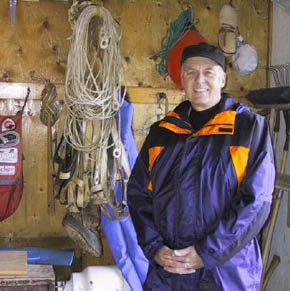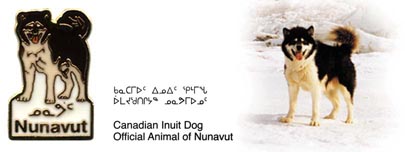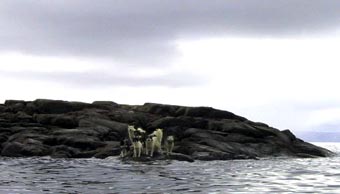Table of Contents
*
Featured Inuit Dog Owner: Ken MacRury, Part 1
*
Remembering Niya
*
Page from the Behaviour Notebook: Bishop and Tunaq
*
Antarctic Vignettes
*
On Managing ISD Aggression
*
The Qitdlarssuaq Chronicles, Part 3
*
News Briefs:
Inuit Dog Thesis Back in Print
Nunavut Quest 2003 Report
Article in Mushing Magazine
Possible Smithsonian Magazine Story
*
Product Review: Dismutase
*
Tip for the Trail: Insect Repellents
*
Book Review: The New Guide to Breeding
Old Fashioned Working Dogs
*
Video Review: Stonington Island, Antarctica 1957-58
*
IMHO: The Slippery Slope
Navigating This
Site
Index of articles by subject
Index
of back issues by volume number
Search The
Fan Hitch
Articles
to download and print
Ordering
Ken MacRury's Thesis
Our
comprehensive list of resources
Talk
to The
Fan Hitch
The Fan
Hitch home page
ISDI
home page
Editor: Sue Hamilton
Webmaster: Mark Hamilton
Contents of The Fan Hitch Website and its publications are protected by international copyright laws. No photo, drawing or text may be reproduced in any form without written consent. Webmasters please note: written consent is necessary before linking this site to yours! Please forward requests to Sue Hamilton, 55 Town Line Rd., Harwinton, Connecticut 06791, USA or mail@thefanhitch.org

Ken standing by traditional seal skin
harnesses and tug
lines Feder photo
Ken MacRury, Part 1
TFH: What brought you to the Arctic? When did you
first arrive? Back
then did you ever imagine you'd have stayed for as long
as you did?
KM: My wife Sheila and I first went to the Arctic
(Frobisher
Bay - now Iqaluit) in 1971 after working as teachers in
southern Canada
for two years, following university. We expected to
stay for the
normal two years and never dreamed that our stay would
last our entire
working career of thirty-one years.
TFH: How did your interest in Inuit Dogs develop?
KM: In 1974 we moved north to Igloolik at the top
of Foxe Basin,
a wonderful traditional community where, for the first
time, we came into
contact with real dog teams and real dog drivers. I was
able to apprentice
to a terrific hunter and dog driver, Pauloosie
Attagutalikkutuk and, over
the next two years, spent considerable time traveling and
hunting with
him by dog team in a very traditional manner. I learned
much from him in
those two years we spent in Igloolik - about dogs, about
sleds, about hunting
and mostly about patience and humor and how to apply them
when living where
you have at best only very limited control over how your
world unfolds.
TFH: What role did you play in the Eskimo Dog Recovery
Project?
KM: When Bill Carpenter came to Igloolik looking
for pure stock
in 1975 and 1976, I assisted him in meeting the right
people. Later we
exchanged breeding stock and worked to support each other
in preserving
the breed.
TFH: What made you decide to choose the Inuit Dog as
the subject
of your master's thesis? Did you ever imagine that your
research would
have such a lasting effect on such a wide
audience?
KM: When I went to Cambridge, UK, in 1990, I
planned on doing
my thesis on "The Inuit Land Claim and Its Impact On
Division of the Northwest
Territories" or some such topic. The topic was not
approved by the
Board of Graduate Studies, as there had been several
theses in recent years
on the Inuit Land Claim, and they decided that there would
be none further
until the Claim was implemented. My thesis adviser
was aware that
I had been doing some private research on Inuit Dogs and
suggested they
could be the topic of my thesis. We then made a
second submission
to the Board of Graduate Studies and the topic was
approved. At the
time I had no idea that the thesis was ever likely to be
published and
certainly not go to multiple printings.

Ken's dog Ruff was used as the model for
Nunavut's Official
Animal and for this cloisonné pin
TFH: Since the Inuit Dog became the Official Animal of
Nunavut, has
the Nunavut Government made any effort to encourage the
pure breeding of
stock and to encourage owners to protect against
needless deaths by vaccinating
against preventable diseases?
KM: Vaccination is made available to team dogs
through the Department
of Sustainable Development, the wildlife officers. I
am not aware
of any efforts on behalf of the Nunavut Government to
promote pure breeding
of the Inuit dog.
TFH: What was your feeding regimen at different times
of the year?
KM: Starting in October, when the team came home
from Holiday
Island, I would feed them every two or three days on
thawed cut up meat
(usually seal but also walrus, whale or fish, rarely
caribou). By
mid-November I would be feeding every second day and that
would continue
all winter until at least the end of March. When
feeding, each dog
would get a mix of meat, bones, organs that had been
thawed out.
The amount would be about three pounds per day per
dog. After April
the feeding could be more erratic as we would be traveling
more and putting
in longer days in harness. At that time of year the
dogs might be
fed every day or not for three or four days and amounts
would also vary
from 3-4 pounds per feed to 8-10 pounds per feed. In
general they got what
they needed and sometimes if we were trying to get rid of
meat before it
got too spoiled they might get as much as they could eat
and more left
over. The dogs would be working until the end of June and,
after a short
wait of ten to fifteen days for the ice to clear, would be
moved out to
the island where they would spend the summer/fall,
mid-July until about
the third week in October. During that time they
would be fed about
once per week if they were all adults. If there were
juveniles on
the island I would feed about twice per week. In
either case I would
take a large bin of meat to the island, perhaps 60-70
pounds and what they
did not eat immediately would be left for later but I
suspect the ravens
and gulls got most of the leftovers. Usually, I would have
six to eight
dogs on the island. I would sometimes take out to the
island a whole seal,
not cut up. As the dogs stood around me I would cut
the seal and
feed them individually by hand while calling their
name. I felt this
reinforced my position, made them remember their training.
It gave me an
opportunity to favor the boss dog but at the same time
remind him that
I was in charge.

On Holiday Island, Ken's team eagerly
awaits his arrival
with their food Feder photo
TFH: How did you train your dogs?
KM: I would start to train the pups as soon as they
took solid
food. I would raise the pups together, never alone
or one pup at
a time. They would be taught to take food from my
hand, never to
grab and to wait their turn. Also they were taught to come
to me when I
called them by name. After that most training was
done by the adults
when the pups were taken with the team - to never stop
until I told them
to stop, to lie down when stopped, not to fight when in
harness, to follow
the leader at all times, not to chase caribou, etc.
Once you have
an experienced team it is very easy to train young
dogs. And if they
are too unruly to fit in or too lazy to work then they can
always be sent
somewhere else and often they will make excellent team
dogs for someone
else.
As the driver it was very important to me to have a team where two positions were absolutely clear: the leader and the boss. I decided who was the leader and I did what was required to ensure the leader felt secure and happy being leader. I believe there are three requirements to be a good leader: a desire to be out front, a desire to please the driver and intelligence. Without all three the leader will never be very good. A good boss dog is critical to a well-ordered team, for without one the team will verge on anarchy all the time. When you have a good boss dog there will be a calm order in the team as the boss will not allow others to fight and will not start fights himself. I had actually gone for years without serious fighting, all due to having an undisputed boss who ran the team with quiet authority. One of the keys to having a well-established boss is to allow the dogs to have extensive opportunity to interact with each other without human interference. If we are forever rushing in to break up every squabble, it does not allow the natural boss to emerge or the team social structure to develop. (Just throwing all the dogs in a cage is a recipe for some serious injuries.) We have to be confident enough in the process and accept the fact that some dogs may get hurt in the process. But in the end it will be a far better team. Each summer my team would spend three-and-a-half months on an island in Frobisher Bay, visited once or twice a week, and would have lots of time and opportunity to sort out the boss question. When that process is in play the losers must have the opportunity to put some space between themselves and the others. If I had not placed nine-year-old Goofy, an aging co-boss dog, when I did, it was very unlikely that he would have survived another year. His brother (and co-boss) had died and he was becoming too slow to keep up with the younger dogs. When a boss dog is deposed he doesn't go to the number two slot, he tumbles all the way to the bottom. It is a sad sight to see an old boss being picked on by young dogs hardly more than pups. It would not have surprised me at all if Goofy had simply disappeared from the summer island, either killed by the other males or forced off the island and drowned.
One caution about boss dogs: there are the rare bullies that do not exert quiet authority but take every opportunity to fight the lower dogs and often do damage to them. Most often these are young aggressive dogs that have not had a good role model or older bosses that are losing their grip on power. In either case they can be dangerous and are best disposed of.
TFH: Please describe for us some details of a good
harness fit. The
traditional harness is quite “economical” in design,
perhaps born out of
necessity since they were originally made out of bearded
seal. Modern so-called
freighting harnesses can be described as more
“elaborate”, but do you think
they are any better for the dog? Do you think that it is
better for dogs
run in tandem?
KM: I always used the traditional sealskin harness
in the colder
weather - October until end of April or so - and switched
to a nylon webbing
harness made in the traditional style for May and
June. I did that
as the sealskin harnesses would have to be dried after
each use in the
spring. That shortens their life and as the older
hunters die it
is becoming harder to get the sealskin harnesses.
The traditional harness is made of one piece of bearded sealskin about four inches wide and three feet long. It is split almost in two lengthways and then the loose ends are sewn back to the sides, a short piece (about six to eight inches) is sewn across the back of the neck and two thin and short adjustable pieces are tied in slits in the main harness across the chest. The whole harness has four pieces. Also there is a tail piece of sealskin rope about 12-16 inches long with a moon shaped toggle of caribou antler or muskox horn attached to it. About fit, it is absolutely essential that a harness fit well if one wishes to get the most out of the dog. The traditional harness was fitted to each dog individually; no such thing as small, medium and large. And it was fitted at the first of each year and on a regular basis during the year as the dog's size changed. The better drivers had a stock of harnesses and I often saw them change a harness when they noticed a poor fit. The sealskin harnesses would mold themselves to fit the dog like a well fitting glove. Adjustments were made to the chest pieces if that was the problem but otherwise the entire harness was changed if the length was not right or the neck strap was too short or long or if the leg hole was not right. Fit is very important and great care is taken to get it right. In my view, the modern harnesses are made for loping or running dogs pulling light loads over good trails. The Inuit dogs pull more with their shoulders and push into their harness. Therefore, they will be more comfortable with a harness that is wider across the neck and is hinged at the chest to allow individual front leg/shoulder movement. The Inuit harness is also best when used with individual traces which allow a greater distance between the pull point and the dog. The harness can then be placed higher on the back as the angle of pull is not as extreme. This allows for more force to be exerted on the load.
I always ran my dogs in a fan hitch and have no experience with tandem. I do think that using the fan hitch allows a lot more interaction between the dogs. I often noticed that when we would be stopped, certain dogs would lie beside their friends although when running they might be separated by quite a distance. I think my dogs were happier in a fan than they would have been in tandem. But then, I never ran where there were trees.
Traditional bearded seal harness, toggle
made from sled
runner plastic,
not
bone
Hamilton
photo
In part 2 of this F.I.D.O. Ken describes the kind of dog that successfully made it onto his team. He talks about purity, the role of genetic diversity, the future of the breed in the Canadian Arctic, and what breeders in the south need to do in order to "substitute" for the lack of culling by the nature of the North.
Editor's note: In the summer of 2002, Ken and Sheila MacRury said good-bye to Iqaluit, retiring to a small community in Atlantic Canada. Although he sold his team to a musher in Iqaluit, Ken took Mabel his lead dog with him.